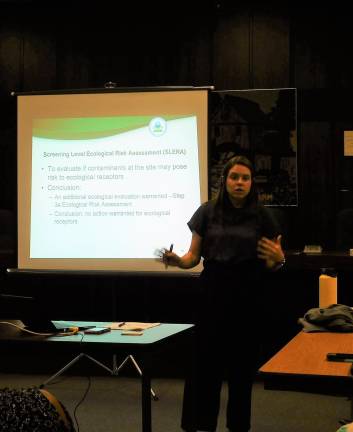EPA plan for second phase of Superfund cleanup
| 12 Aug 2019 | 06:34

Anne Rosenblatt, EPA site manager for the Mansfield Trail Superfund site in Byram, presents options for the next phase of remediation, at a meeting held Tuesday, July 23, 2019 at the Byram Municipal Building. (
)
On Tuesday, July 23 the Environmental Protection Agency (EPA) met with the residents’ Citizens Action Group (CAG) affected by the Mansfield Trail Superfund site, to propose its plan for the second phase of remediation. The site, which was identified as an illegal toxic dump in 2005 and placed on the National Priority List in 2011, is currently in the first phase of remediation, which included removing the majority of the contaminated soils and installing POET (point of entry treatment) systems for the water in 19 homes near the dump site. The first phase, called Operating Unit 1 (OU1) will reach completion with the connection of those homes to service from a local water company. The meeting on Tuesday was to introduce residents and the public to the EPA’s testing results and proposed action for Operating Unit 2 (OU2), which will provide long-term remediation to the site. Anne Rosenblatt, the EPA project manager for the site, presented deteails on the options the agency deems viable after the latest round of testing and assessment. Other EPA representatives included community relations coordinator Pat Seppi, Human Health Risk Assessor Abbey States, and remediation projects supervisor Kim O’Connell. The NJDEP’s Mark Herzberg and Larry Jordan from CDM Smith, who prepared the reports and renderings, also attended the meeting, as well as Byram Councilman Scott Olson and Kellie Doucette, a liaison from the office of Congresswoman Mikie Sherrill (D, NJ-11). Rosenblatt explained that OU2 would have two components, one to remedy the groundwater and the other to address the remaining soil contaminants. She said the nature of the landscape makes the site an exceptional case, and that several options needed to be weighed. “The complex geology and fractured bedrock under the ridgeline make it hard to trace the groundwater,” Rosenblatt said, “and that’s crucial to keeping any leeched contamination out of the creeks nearby. The point of OU2 is twofold; to reduce or eliminate the exposure of humans to contaminants, and to minimize the spread and exposure of the contaminants to ecological elements.” Rosenblatt presented a series of options to remedy both the groundwater and the soil at the site, which could include vapor extraction, capping, soil amendment injections, and further excavations. The EPA is recommending what they call option GW-4 for the groundwater remediation and option S-3 for the soil. GW-4 calls for the capping of the sites with impervious material to prevent runoff or rain from washing any lingering contamination into the groundwater. The option also calls for the installation of a vapor evaporation system, which Rosenblatt describes as a “vacuum” for removing toxins from the soil to be taken from the site and properly destroyed. The third component of GW-4 is to inject chemical amendments into the bedrock to neutralize toxins and speed up the natural remediation process. Option S-3 calls for removal the small amounts of contaminated soil which remain at the site after the mass removal in 2012. Rosenblatt said the remaining soil is minimal, and removing it will alleviate the health risk to humans and the environment. The alternatives are all evaluated using a system of nine criteria, including primary actions, long-term monitoring needs, and health thresholds. The EPA’s full report can be found at https://www.epa.gov/superfund/mansfield-trail for information on the other considered alternatives. The EPA’s O’Connell said that OU2 is a huge step towards a full remediation at the site, and the agency will also be using what they call MNA, monitored natural attenuation, to track the progression of the site’s improvement. “Obviously, our final goal is for the site to be completely clean,” O’Connell said, “But that could take decades on its own, so these treatments will help the process along.” Rosenblatt said the fractured bedrock makes it conducive to natural attenuation, the process by which the earth cleans itself over the course of time. According to Rosenblatt and O’Connell, the two Operating Units can be run concurrently, as long as the design phase for the public water line stays on schedule. “Our short-term goal was to get everyone potable water, that’s why we have the POETs; then we’ll get everyone connected to public water, and continue to monitor those homes through that process,” O’Connell said, “and once that’s done, we can focus on OU2. The water line has to be in first, so we don’t cross-contaminate anything during OU2.” The EPA is welcoming public comments on the proposed plan through Aug 13. All feedback can be directed to Rosenblatt at rosenblatt.anne@epa.gov or mailed to her at U.S. EPA Region 2, 290 Broadway, 19th Floor, New York, NY, 10007-1866. During the public comment portion of Tuesday’s meeting, Councilman Olson presented a memo from resident Donna Griff, who was unable to attend. The letter urged the EPA to listen to those most closely touched by the issue. “We, the 20 (households), have been living on the site for 15 years,” Griff’s note read in part. "This isn’t about drinking water. This is about the health and safety of my family. I hope the EPA will allow for more weight from the voices of the affected residents, and not those who may not have our best interests at heart.” Once the public comment period ends, the EPA will complete a Record of Decision for OU2. It’s expected that the final report will be delivered in September 2019.